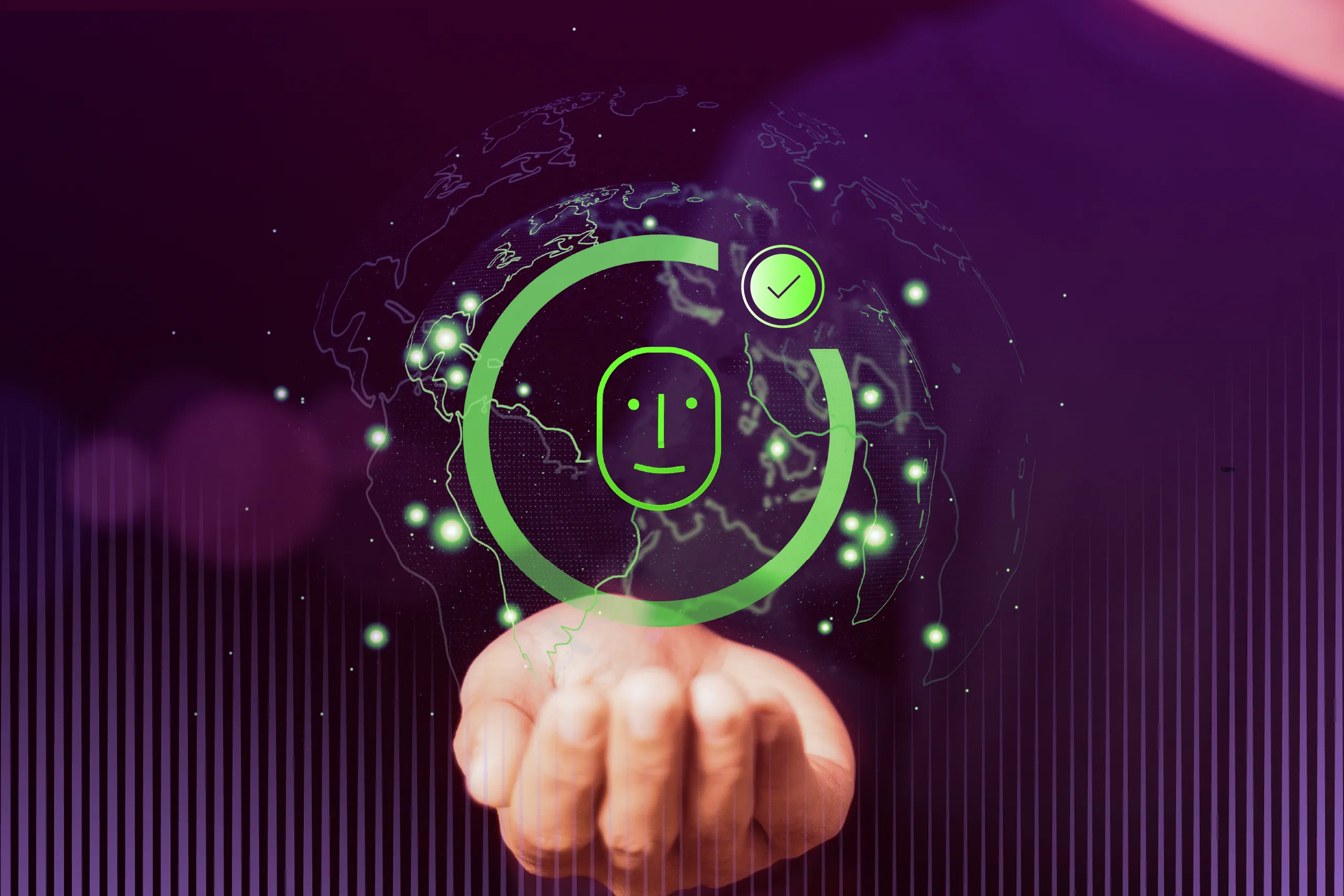What to expect in this blog
How do organizations can verify someone’s identity online, securely and without hassle?
This article breaks down the basics of remote identity verification, explains the typical steps, and highlights practical advantages for both users and businesses.
Remote identity verification has become a staple of authentication following the remote work and remote onboarding boom. Millions of people worldwide open bank accounts, start new jobs, and access new services entirely online—and for good reasons. When done right, remote ID verification is simply more convenient for customers and more cost-efficient for organizations.
How exactly does it work? In this article, we explore the nature of remote identity verification, as well as its core benefits.
Subscribe to receive a bi-weekly blog digest from Regula
What is remote identity verification?
Remote ID verification is the process of authenticating a user’s identity through digital means. It is usually done by validating their government-issued ID document with a comprehensive set of authenticity checks such as RFID chip reading and/or hologram detection. On top of that, remote ID verification increasingly uses biometric factors like facial recognition and liveness detection to be confident that the user is both present and legitimate.

In a typical remote IDV flow, OKX users are required to take a selfie while holding their ID to complete verification.
Some common use cases for remote identity verification include but are not limited to:
Customer onboarding and KYC compliance
Authentication after onboarding (login to user accounts, admin portals)
Employment eligibility and remote hiring
Access to government services and benefits
Age verification for restricted services
High-value transaction approvals (banking wire transfers, cryptocurrency withdrawals)
Access control for secure digital records (healthcare portals, legal files, education platforms)
Account recovery after loss of access credentials
Step-up authentication when session behavior or geolocation appears suspicious
How remote identity verification works
Remote ID verification relies on a combination of document authentication, biometric matching, and liveness detection to reproduce the level of trust one would get with a face-to-face check.
The process can be broken down into five key steps, often executed within one holistic workflow. It’s worth mentioning that the chronology of these steps is rather a formality, since some of these operations happen almost simultaneously.

Step 1: Document capture
The user is prompted to capture images of their ID document (e.g., the front and back of a driver’s license) using a smartphone camera. Some remote identity verification systems can even be customized to guide the user with on-screen overlays or automatic capture triggers to ensure the document is fully in frame and in focus.

A standard example of a document capture prompt.
A common technical challenge at this stage is variations in conditions: low lighting, motion blur, or reflections on holograms can negatively affect the next steps. That is why solutions should be able to instruct users to adjust positioning or angle if necessary.
Step 2: Document authentication
Once the ID images are captured, the next phase is document authentication—verifying that the ID is legitimate, unaltered, and valid. The system uses the images from the capture stage as inputs for analysis, automatically recognizes the document type, and performs a series of automated authenticity checks:
Analyzes the visual inspection zone (VIZ) to extract personal data (name, date of birth, document number, etc.) and detect inconsistencies.
Reads machine-readable zones (MRZs) and barcodes, verifies formats and check sum.
Verifies digital signatures encrypted into barcodes.
Reads and authenticates RFID chips, with additional verifications on the server in a customer’s secure perimeter.
Verifies dynamic security features, including holograms and optically variable ink (OVI) for document liveness detection.
Checks the document for cross-field consistency.
Ideally, the system should be able to support many ID types from all across the world (different countries, years of issue, special formats, etc.). For example, Regula Document Reader SDK features one of the world's largest template databases, comprising 16,000 ID documents from 254 countries and territories.
Step 3: Biometric capture
Biometric capture involves collecting one or more biometric samples from the user to verify that the person behind the device is indeed the rightful owner of the ID. In most remote verification scenarios, the primary biometric used is the facial image—essentially a selfie taken by the user. Face recognition is prevalent because virtually all IDs include a photo, and modern smartphones/laptops make capturing face images easy. Other biometrics like fingerprints or voice are less common in remote scenarios: fingerprint capture would require special hardware or phone sensors, and voice verification is not widely used for ID proofing.

Many solutions offer a guided selfie capture process that automatically takes a photo once the face is in focus and the lighting is good.
Users may be asked to remove any obstructive items (glasses, masks) and hold the camera at eye level. The software might also give feedback like “Too dark, move to a brighter area” or “Face not fully in frame” to help the user take a usable image.
A special feature of many facial recognition systems like Regula Face SDK is liveness detection, similarly to how it works with documents. The idea is to ensure that the system is interacting with a real person in real time, and not an elaborate spoof. The user may be asked to turn their head left/right, blink, and/or smile—this is referred to as active liveness detection.
Alternatively, there is passive liveness detection, which is considered less intrusive, but also slightly less reliable: without explicit user action, the system looks for subtle features like skin texture, light reflection in the eyes, and face depth.
Step 4: Face matching
The next step is comparing the face from the selfie (live capture) to the photo from the ID document.
First, both images undergo preprocessing—faces are detected and cropped, aligned (e.g., eyes leveled), and sometimes enhanced (to normalize lighting). Then, the algorithm processes each face, typically using high-dimensional vectors in which distance corresponds to facial similarity.
Then, 1:1 verification is performed, where Face A (selfie) is compared to Face B (ID photo). Another option is 1:N identification, where the system compares the selfie not to a single photo, but to an entire database or a watch list. The system will have a decision threshold for what score constitutes a match, which can be adapted depending on the security requirements. For example, logging into a low-risk account might tolerate a slightly lower confidence level, whereas remote identity proofing for a government service might need an extremely high confidence level.
If the ID is an e-passport or e-ID with an NFC chip, the comparison will often use the facial image stored on the chip for higher quality. The chip image is a digital original, which is usually higher resolution and not degraded by printing/scanning, so matching with the live selfie tends to be more accurate.
Step 5: Risk scoring and decisioning
Rather than a simple binary pass/fail on each check, the system considers all signals holistically to decide how confident it is that the user’s identity is verified and whether any risk factors are present. It takes into account the outcomes of document authenticity checks, liveness results, face match score, and sometimes additional data (e.g., device or network signals, geolocation, behavior patterns) to produce a composite assessment. The output is often a numerical risk score or a categorized result (e.g., low risk, medium risk, high risk) which will inform the final decision.
As for the decision itself, it is not necessarily limited to “Approved” and “Denied”, as many systems have an intermediate outcome for cases where some risk is identified, but the confidence level is not high enough to flatly reject. These cases are flagged for manual review by security or compliance staff.
Some remote identity verification workflows may even incorporate a live video interview with the user by default. It acts as a human-in-the-loop (HITL) safeguard, during which an agent manually validates the user’s identity in real time. Such live interviews are often reserved for high-risk cases or when certain standards require a supervised identity check.
Benefits of remote identity verification
Remote identity verification has gained a lot of traction because it addresses many modern needs—and in a very modern way.

Providing convenience and efficiency
Remote identity verification allows people to prove who they are from anywhere without needing to present physical IDs in person. Not only is it very convenient, but also much faster and more efficient than in-person checks. And, from a business perspective, this can quickly translate into higher completion rates, as users are less likely to drop off during this improved version of onboarding.
For example, a digital ID provider React has recently partnered with Regula to automate over 90% of its ID verification workflow, which cut its customer onboarding time to under 30 seconds per user.
Enabling global reach
Remote ID verification also offers unprecedented scalability and reach. Because verifications are handled online, organizations can verify the identities of users around the world without needing physical offices or local agents to inspect documents.
This became particularly vital during the COVID-19 pandemic, and continues to support remote and hybrid work arrangements. For example, many U.S. employers hiring out-of-state remote workers have embraced remote I-9 verification options. Since August 2023, the Department of Homeland Security has allowed an alternative procedure where employers enrolled in E-Verify can examine Form I-9 documents via live video instead of physically handling them. For companies in the E-Verify program, this means they can hire and verify a worker’s identity entirely remotely—a huge boost for scaling teams across multiple locations.
Improving fraud detection
It may seem counterintuitive, but remote verification can actually enhance fraud detection compared to traditional methods. This is thanks to advanced technologies that scrutinize IDs and user selfies in ways that humans might miss.
Modern IDV solutions like Regula Document Reader SDK can perform a number of advanced checks on IDs. This includes reading the machine-readable zone (MRZ), validating RFID chip data, and inspecting all major dynamic security features including holograms, optically variable inks (OVI), multiple laser images (MLI), and, most recently, Dynaprint®. They also employ liveness detection for both documents and selfies, making sure that the ID or person on camera is really present.
Helping regulatory compliance
Regulators around the world are adapting their rules to accommodate (and sometimes mandate) secure remote identity verification. When done correctly, it can help organizations meet these requirements more efficiently and flexibly than traditional methods.
For instance, KYC and AML laws require banks and fintech companies to verify customer identities and spot fraud—procedures where remote verification technologies are now integral. One of our recent cases saw European fintech company iCard move to an automated ID verification system with document and biometric checks in an effort to keep up with Europe’s strict regulations.
Additionally, remote ID verification helps auditability as every check is logged and all evidence (e.g., snapshots of the documents) is retained.
How Regula makes remote ID verification possible
Remote identity verification is allowing businesses and institutions to know who they’re dealing with online—and with higher levels of confidence—as solutions evolve.
Regula is proud to be part of that evolution, offering cross-platform remote ID verification solutions for all organizations, combining document forensics, chip reading, and face recognition.
Regula Document Reader SDK processes images of documents and verifies their real presence (liveness) and authenticity. The software identifies the document type, extracts all the necessary information, and confirms whether the document is genuine. On top of that, the SDK leverages mobile NFC verification and complete server-side verification to confirm the genuineness of the RFID chip.
At the same time, Regula Face SDK conducts instant facial recognition with liveness detection, and prevents fraudulent presentation attacks such as the use of static face images, printed photos, video replays, video injections, or masks.
Let’s drive the future—together. Book a call to learn more about our solutions!





